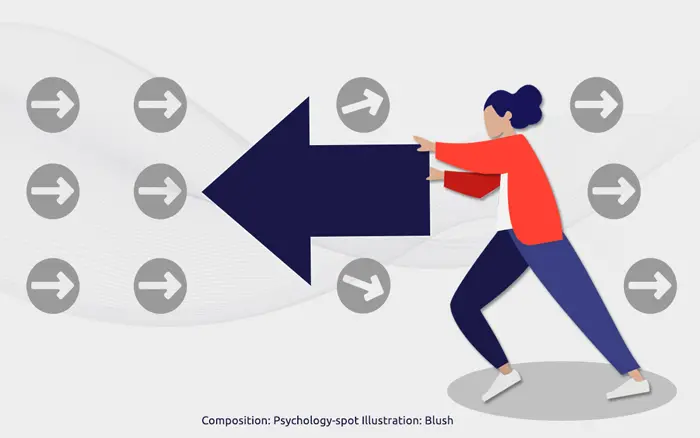
The different types of resistance to change are the result of our tendency to stick to habits and customs, to all those things that we know and give us security. The problem is that “Change is the only immutable thing” in our lives, as Schopenhauer said, so that if we do not accept it, we will end up developing maladaptive behaviors that in the long run could make us suffer more or lead us to make bad decisions.
The origin of different types of resistance to change
Our brain, to optimize its resources, has a tendency to save energy. That means it tends to prefer stability and the known to chaos and change. In known situations it knows how to react, so it simply activates the default response patterns. The change implies an alteration of that system and means having to look for alternative answers. So we resist.
That resistance, however, is usually temporary. We usually end up accepting change and taking on the new challenges it represents. But sometimes, it is different. There are times when we get caught up in the past, in old patterns, and deny change. That behavior is not functional because denying something will not make it disappear, but will end up amplifying our frustration, sadness or anxiety.
Understanding where our resistance to change comes from is critical to overcoming it and responding more adaptively and intelligently. Thus, we can find different types of resistance to change that we will probably show at some point in our lives:
1. Resistance to risk. When the changes involve a high level of risk that we are not willing to assume, we can develop a strong resistance. This type of change forces us to leave our comfort zone, causing us to abandon security, which is why it usually generates a feeling of intense fear. Changing a stable job as employee to start a business on our own, for example, can generate this type of resistance due to the economic risk involved.
2. Resistance by attachment. We have a hard time accepting the changes in interactions and bonds that we have established. Therefore, when change implies a transformation of relational dynamics, it can unleash great resistance. The possibility that a close person that we love moves to another country, for example, generates a strong resistance because we will have to assume that the meetings will be much more sporadic and we are afraid that the emotional bond may weaken.
3. Cultural resistance. This type of resistance to change stems from our beliefs, values, or even culturally shared prejudices and stereotypes. Our identity – or at least part of it – also rests on the social vision we share with a group of people, so if the change calls into question those values, expectations or beliefs, we will develop resistance as a defensive measure to protect that part of our essence. That is the reason why we encounter such great resistance when trying to eradicate a popular tradition deeply-rooted.
4. Resistance for antagonistic interests. Resistance to change is not always an unconscious process, sometimes it is the result of a logical and systematic analysis of the situation. If we consider that a change affects our interests, desires or objectives, it is normal that we react with resistance. A drop in wages, for example, generates an understandable resistance as it goes against our interests.
5. Resistance for misunderstanding. Many times, especially when the change takes us by surprise, we fail to understand what is happening. In fact, most of the changes have “gaps” that we need to fill. If we fail to fill those gaps because we cannot make sense of change, we will try to take refuge in the known, that which makes sense to us. This type of resistance to change is common when a person is abandoned by his partner and this does not provide explanations that allow him to give a more or less coherent meaning to what is happening.
6. Resistance by denial of reality. Sometimes changes bring unintended consequences that are difficult for us to assume. If we do not have the necessary psychological resources to face these changes, we can put in place maladaptive defense mechanisms, such as denial, which consists of closing our eyes to what happens by denying change. This type of resistance to change is common in parents who refuse to accept that their children have grown up, so they continue to overprotect them and decide for them as if they were young children.
7. Resistance by uncertainty. Almost all changes bring with them some degree of uncertainty. If that uncertainty is too high and we cannot manage it, it can generate great resistance. This type of resistance is common in people who have a more rigid style of thinking and do not have psychological tools to manage uncertainty. Moving to another country without first having a contract, for example, may be an unacceptable possibility for those who cannot tolerate the uncertainty of change.
8. Overload resistance. Even the most flexible and open people can experience resistance to changes, especially when they end up accumulating. We all have a threshold of tolerance to uncertainty, if we experience too many changes, some of them important or vital, in a short period of time, it is understandable that we feel psychologically overloaded and end up resisting any other change that occurs, however small or positive for us.
The 3 reactions to change: Fight, paralysis or adaptation
Although resistance to change can have different origins and explanations, our repertoire of responses to a transformation that affects us directly is usually very limited: we fight against change, we become paralyzed or we adapt.
1. Active resistance to change
Facing a change that we do not like, the most common thing is that is activated our fight or flight response. We can actively fight these transformations to try to reverse them or at least mitigate their impact. In that case our goal is to undermine the foundations of change in order to try to nullify it.
However, we can also take on an active attitude by escaping the stage of change. That would imply keeping as far as possible our habits, ways of thinking or relationships looking for a new scenario that recreates what we already know. In practice, we run away from the place or relationship that has generated insecurity and instability to find another place or relationship where we feel more comfortable.
2. Passive resistance to change
When passive resistance occurs we do not engage in change in any way. In fact, we assume a passive attitude, we remain silent, we do not express what we think or feel, we do not act. That passivity is the way to demonstrate our dissatisfaction with change and, in a certain way, a covert resistance to dynamite it.
This response responds fundamentally to a situation of paralysis. When we are facing a situation that scares us is not always unleashed a fight or flight response, sometimes we are paralyzed. It is as if we want to hide and stay safe until change is passed.
3. Adaptation to change
Changes can carry risks or even represent real threats. But on many occasions it is not in our hands to reverse them, so the best response is usually to adapt to circumstances.
That adaptation does not mean “undergoing change” but, first of all, trying to minimize its psychological impact in a way that does us less harm. And secondly, trying to find a positive side from which we can take advantage. After all, “When we are no longer capable of changing a situation, we face the challenge of changing ourselves”, as Viktor Frankl said.
Sources:
Castro, P. & Batel, S. (2008) Social Representation, Change and Resistance: On the Difficulties of Generalizing New Norms. Culture & Psychology; 14(4): 475-497.
Oreg, S. (2003). Resistance to change: Developing an individual differences measure. Journal of Applied Psychology, 88(4), 680–693.
Pardo del Val, M. & Martínez, C. (2003) Resistance to change: a literature review and empirical study. Management Decision; 41(2): 148-155.



